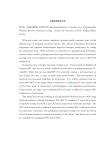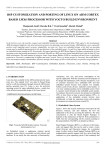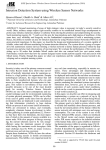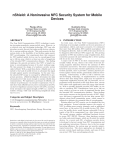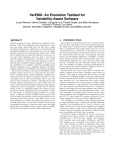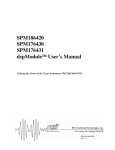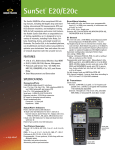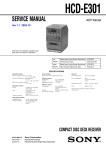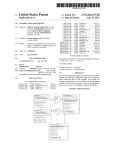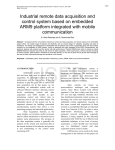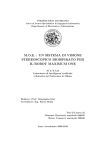Download Energy-Efficient Platform Designed for SDMA Applications in Mobile
Transcript
IEEE WCNC 2011 - Service and Application Energy-Efficient Platform Designed for SDMA Applications in Mobile Wireless Sensor Networks Xiwei Zhang1,2 1 2 Guihai Chen1 Department of Computer Science, Nanjing University Department of Computer and Information, Hohai University Nanjing, Jiangsu, China [email protected] [email protected] Abstract — Although advance network planning and dense node deployment, wireless sensor networks (WSNs) may achieve the required performance, it still face the fundamental challenge of meeting stringent power and time requirements using nodes with limited sensing capacities. To better cope with the power consumption problem, mobile sensor nodes can be introduced to dynamically reconfigure the sensor network capacity in an on-demand manner. Through data gathering and relaying, mobile nodes can reduce the amount of data transmitting between the static nodes then conserve the power of these nodes to prolong the lifetime of network. In this paper we describe the DataTruck, a new open-source sensing platform specifically designed to support our experimental research in mobile sensor networks, which is used to collect or relay data from static sensors. The DataTruck node is designed around the S3C2440A ARM920T RISC microprocessor and the IEEE 802.15.4 compliant CC2431 radio from Chipcon. Mobility is enabled with an additional accessory board that allows the node to drive its 4 linear motion actuators. To reduce power consumption, a long term sleep mode is supported through different power supplying methods for main board and clock. Furthermore, we integrated a smart antenna system to gather the data from multiple static nodes concurrently which transmitting data using the same frequency of channel. The experiments show that DataTruck collects data efficiently to reduce the average data transmission delay by using SDMA technology. Keywords — wireless sensor networks; mobile sink; SDMA; smart antenna I. INTRODUCTION In recent year wireless sensor networks (WSNs) have been used to monitor physical or environmental conditions, collect or transmit sensing data. These networks can serve as an infrastructure for a number of applications including surveillance, medical monitoring, agricultural cultivation, facility monitoring, and entertainments [1, 2]. For a number of these applications, sensor nodes could be deployed in a vast area or in harsh environments. As a result, a large network deployment may require excessive sensor nodes in order to achieve satisfactory sensing performance. Moreover, although dense node deployment may initially achieve the required performance, it does not adapt to dynamic changes of network 978-1-61284-254-7/11/$26.00 ©2011 IEEE conditions or physical environments. For instance, death of nodes due to battery depletion or physical attacks can easily cause coverage holes in a monitored battlefield. With recent advances in robotics and low power embedded systems, mobile nodes [3, 4, 5, 6, 7, 8, 10] are becoming a viable choice for the sensing applications mentioned above. These mobile nodes may be mobile data ferries, or mobile data relays, which responsible to collect or relay data from the sensor nodes to base station. In this approach, a small number of mobile devices referred to as data ferry roam about sensing fields and collect data from sensors. As a result, significant network energy saving can be achieved by reducing or completely avoiding costly multi-hop wireless transmissions. On the other hand, if the mobile node has sense ability, called mobile sensor, it can cover more area than a stationary sensor over a period of time because it can move to anywhere to capture the event. Mobile nodes can promote the network performance efficiently. We know for a random deployment in static sensor networks, the sensor density should increase as to provide -coverage in a network with size of . In [3], authors prove an all mobile sensor network can provide -coverage over the field with a constant , independent of network size . density of Mobile Wireless Sensor Network (MWSN) can be mainly divided into two categories. One is all nodes in the network are mobile. However, these nodes only have limited mobility to maintain the steady of network [5]. The other category is widely researched that part of nodes in the network are mobile and the other nodes are static, so the network is called hybrid network. In this network, static nodes are responsible for data sensing, and the mobile nodes move to them to collect or relay the data to base station. A classical application of a hybrid network is depicted in Figure 1. In this paper, we design a mobile sink node named DataTruck. Mobile sink usually has no sensing ability, so the main function of DataTruck is collect or relay data from other static sensors. DataTruck is a new sensor node platform designed to support mobility experiments in sensor networks. Although our design is driven by the research requirements of our group, extra effort was taken during the design phase to specify a feature set that is complimentary to existing 2089 platforms and can serve multiple aspects of research and education in sensor networks. The DataTruck platform is built around a S3C2440A ARM920T RISC microprocessor from Samsung Semiconductor and a CC2431 radio with a 250kbps raw data rate from Chipcon. The choice of the S3C2440A microcontroller provides a wealth of peripherals and flexible modes of operation. The Chipcon radio and its use with an IEEE 802.15.4 compliant MAC protocol, make our node interoperable with other sensor nodes available in the community such as Telos and Micaz. Fig. 2. The hardware design graph of main processing unit Fig. 1. In this hybrid network, static nodes send data to rendezvous points at first, and mobile node only needs to visit the rendezvous points to save the data delay transmission for the moving trajectory of mobile node is shortened. Although the above schemes can perform data gathering in MWSN well, there still exist some disadvantages. For example, when the DataTruck in the intersection area of communication range of several nodes, it should gather data one by one which increases the transmission delay. In this paper, we improve the performance of data gathering in WSNs by considering two critical factors: mobility and space-division multiple access (SDMA) technique. To the best of our knowledge, this is the first work that introduces SDMA technique to mobile sink node design and explores the utility of a joint design of mobility and SDMA technique in data gathering schemes. The rest of this paper is organized as follows. Section II introduces hardware design of DataTruck and the compare of other mobile nodes. In section III, we design a dual-antennas system on DataTruck using smart antenna technology based on SDMA. Section IV presents experiment and simulation results and section V concludes the paper. II. HARDWARE DESIGN A. The core circuit board The architecture of DataTruck is depicted in Figure 2. The main processing unit is a S3C2440A ARM920T RISC microcontroller [13]. We found this processor to be an appealing choice since it provides a rich set of peripherals, multiple power options and a suitable memory configuration. The CPU core of S3C2440A is a 16/32-bit ARM920T RISC processor which offers outstanding features. The ARM920T implements MMU, AMBA BUS, and Harvard cache architecture with separate 16KB instruction and 16KB data caches, each with an 8-word line length. By providing a complete set of common system peripherals, the S3C2440A minimizes overall system costs and eliminates the need to configure additional components. Operating System and Communication Protocol Stack: To make DataTruck interoperable with other devices, we ported Chipcons IEEE 802.15.4 compliant medium access control protocol which we operate inside the ARM Linux operating system. DataTruck Support API: In order to support the special features of DataTruck we implemented a specialized protocol that consists of the following modules: Power Manager Module To support long term deep sleep we have implemented a supervisor circuit outside the processor operated by a real-time clock (RTC) with two interrupts. With this circuit, the node has software control to transition into a deep-sleep mode by disabling its main power supply regulator. The RTC is directly powered by the batteries and not by the on-board voltage regulator. This allows the RTC to keep track of time with its own oscillator, when the voltage regulator powering the rest of the board is disabled. Device Drivers Module This component includes the low level interfaces to all the devices and the I/O peripherals on the DataTruck including the radio, the Real Time Clock, the ADC, the UART, the timers and the DMA controller. Using this module, applications can easily use all the devices connected to the various I/O interfaces of the node. Radio Manager Module This module is responsible for configuring the communication subsystem. Applications can call this component to change the transmission power level of the radio and/or its security configuration. Frequency Manager Module The frequency manager is responsible for changing the operating clock frequency of the node while preserving the correct timing of the operating system, the Zigbee MAC layer and the application running on the node. B. The motor drive circuit DataTruck uses L298P as motor circuit to drive its 4 linear motion actuators. The L298 is an integrated monolithic circuit in a 15-lead Multiwatt and PowerSO20 packages. It is a high voltage, high current dual full-bridge driver designed to accept standard TTL logic levels and drive inductive loads such as relays, solenoids, DC and stepping motors. Two enable inputs are provided to enable or disable the device independently of the input signals. The emitters of the lower transistors of each bridge are connected together and the corresponding external terminal can be used for the connection of an external sensing resistor. An additional supply input is provided so that the logic works at a lower voltage. The motor drive circuit is depicted in Fig.3. The speed of motor is calculated using formula (1), which is adjusted by controlling the PWM duty cycle through programming. Suppose is maximum rotation speed of . motor, duty cycle is , the average speed of motor is (1) In this formula, is a duty-cycle. is a value of cycle of a timer, which is preset by the processor and is the time of high level in the cycle which is set in the program to . satisfy 2090 D. Software design In order to identify each node in mobile sensor network which contains more than one mobile node and several static sensor nodes, each node must have unique address and specific transmitting format. The address of mobile node is composed of a CC2431 code, which can be a fixed value, and a node code. We assume the node code is an increasing integer value like 0, 1, 2, 3 and etc. The transmitting format is listed in Table 1. Table 1. Transmitting format of nodes # Fig. 3. The schematic of motor drive circuit C. Wireless RF communication circuit DataTruck uses CC2431 (CHIPCON-CC2431, 2007) as the control chip of wireless communication circuit. The CC2431 is a true System-on-Chip (SoC) solution specifically tailored for IEEE 802.15.4 and ZigBee applications. It enables ZigBee nodes to be built with very low total bill-of material costs. The CC2431 combines the excellent performance of the leading CC2420 RF transceiver with an industry-standard enhanced 8051 MCU, 128 KB flash memory, 8 KB RAM and many other powerful features. The CC2431 is highly suited for systems where ultra low power consumption is required. This is ensured by various operating modes. Short transition times between operating modes further ensure low power consumption. This is ensured by various operating modes. Short transition times between operating modes further ensure low power consumption. It need less than 0.6μA current consumption in standby mode, where external interrupts can wake up the system. SurNo DesNo Length data1 … datan CRC # The means of the notations in the table are as follows. # — the message package is start and end with it SurNo — address of source node DesNo — address of destination node Length — package size datan — nth sensing data want to transmit to next node CRC — cyclic redundancy check code While DataTruck enters the sensing area it will send linking requests to static nodes and set CC2431 in receiving mode. Address resolution will be done if DataTruck received sensing data correctly, otherwise it send a retransmission signal. When the DesNo in the received package is matched with the current DataTruck address, the package will be handled in the local node. Otherwise, the DataTruck modifies the SurNo of the package as the current DataTruck address and relay it to the next node or base station. The data transmission workflow is described in Fig.6. Fig. 4. Appearance of CC2431 The picture of CC2431 is shown in Figure 4, and the schematic of wireless RF communication circuit used in our system is depicted in Figure 5. Fig.6. The data transmission workflow The photo of DataTruck is depicted in Figure 7 and the comparison between DataTruck and other mobile nodes (such as Robomote[7] and XYZ[8]) is listed in Table 2. III. Fig.5. Schematic of CC2431 in DataTruck DESIGN OF MULTI-ANTENNAS ARRAY A. SDMA Space-Division Multiple Access (SDMA) is a channel access method based on creating parallel spatial pipes next to higher capacity pipes through spatial multiplexing and/or diversity, by which it is able to offer superior performance in radio multiple access communication systems. 2091 Table 2. Comparison between DataTruck and other mobile nodes Parameters CPU DataTruck ARM9 S3C2440A Robomote AVR Atmel 8535 Communication CC2431 module Number of motors 4 Maximum speed(cm/s) 130-180 Storage(K) 128 External Storage(M) 16 Data uploading speed 250 (kbps) External A/D yes interfaces Maximum running 10 time(hr) Operation system uc/os-II ķXYZ is a node move along a string, so it aspects. XYZ ARM7 OKI ML67Q5002 UART CC2420 2 15-20 1 0 ķ ķ 32 2 192 250 no yes 1 ķ tinyos SOS cannot be compared in these Fig. 7. A node of DataTruck The kernel part of SDMA is smart antenna. Smart antennas (also known as adaptive array antennas, multiple antennas and recently MIMO) are antenna arrays with smart signal processing algorithms used to identify spatial signal signature such as the direction of arrival (DOA) of the signal, and use it to calculate beamforming vectors, to track and locate the antenna beam on the mobile target. In SDMA system the beams are like multiple space division channels. It provides a new domain, named space domain, expect other three domains (time domain, frequency domain and code domain). Although when the user is utilizing the same frequency and address code in the same time, they can use the space-division channels to promote the capacity of communication system. B. Design of dual-antennas system In this paper, we are mainly consider the case when the DataTruck is equipped with two antennas, because it is not hard to mount two antennas on the DataTruck, while it will likely become difficult and even infeasible to mount more antennas due to the constraint on the distances between antennas to ensure independent fading. Now we will present the design of a smart antenna system with dual-antennas. Smart antennas have two main functions: DOA estimation and Beamforming. In this paper, smart antenna achieves DOA and identifies the directions of the received signals around the array antenna using the MUSIC (Multiple Signal Classification) algorithm [10]. We control the direction of the main beam by the LS-DRCMA (least squares-de-spread re-spread constant module algorithm) algorithm [11] and thus track the desired source signal, and at the same time generate deep nulls in the direction of interfering signals. Here we use dual FPGA and DSP chip to design the smart antenna system, which is shown in Figure 8. In Figure 8, the CORRELATE module in FPGA-B uses the signal which is transmitted from FPGA-A after beamforming to synchronize all signal data. The synchronization point is delivered to DSP and the signal data is despreaded in DEMODULE module and then is transmitted to DSP to respread. The data after respreading is used to be the desired signal for weight solving of Cholesky-LS module. Another goal of these data is send to ERRORCODE_RATIO module for solving the error data rate which is the parameter of the state of system. The sensing data from AD6645 were sent to DDC for wave tracking which means the signal frequency will be nulled from 40MHz after AD sampling. The signals will be orthogonalized and sent to X_DPRAM module and DBF module. X_DPRAM module translates these 4 line concurrent data to 32-bit serial data and sends these data to DSP for weight solving using EDMA mode through EMIFB interface. The functions of DSP mainly include scheduling and computing. For instance, in DSP there are some modules which are used to control the synchronization state of system, and regenerate the desired signal after respreading, etc. The system needs initialization and the ResetFPGA( ) function is called to set the parameters of FPGA. After initialization DSP reads synchronization point and respreading data from FPGA-A to determine whether the system is enter the synchronization state. Then the DSP recalculate the weight and update the weight value in the FPGA-B, and compute the error code rate at the same time. Fig. 8. The architecture of smart antennas system C. Selection of compatible source nodes Due to the smart antenna cannot null the interference which in the same direction of desired signal, not any couple of sensor nodes can send data to DataTruck. In order to revert to the original data, the source couple of nodes should satisfy certain conditions, which we call this couple of nodes is compatible [12]. In this section, we use Linear Decorrelator Strategy (LDS) to analyze this problem. To guarantee that the decorrelator operation is successful, we need to limit the number of simultaneous data streams to no more than the number of receive antennas. In other words, since the DataTruck is equipped with two receiving antennas, at most two sensors can send data simultaneously to the DataTruck. Figure 9 shows the transceiver architecture of SDMA with the linear decorrelator. For simplicity, we will use to denote which represents the complex channel coefficient vector (or called spatial signature) and the two receive antennas of the between sensor DataTruck. and are the two columns of the channel coefficient matrix . Suppose sensor 1 wants to send data and sensor 2 wants to send data . The received vector at the DataTruck can be written as 2092 (2) where is channel noise. We can see from Eq. (2) that each data stream faces an extra source of interference from the other data stream. An idea that can be used to remove this inter-stream interference from an interested sensor is to project the received signal onto the subspace orthogonal to the one spanned by the other and as the filter channel vector. That is, we choose vectors for sensor 1 and sensor 2, respectively, which satisfies and . Hence, the received signal can be decoded as (3) After processed this way, the inter-stream interference can be any vector that lies in nulling can be achieved. which is the space orthogonal to , however, to maximize the received signal strength, should lie in the same direction as the projection of onto . should be similarly chosen. and can be unit vectors because increasing the length of them will not increase the SNR. and can be expressed as follows. Fig. 9. Linear Decorrelator Strategy (LDS) in SDMA IV. EXPERIMENTS AND SIMULATIONS To compare the proposed solution, we have made two kinds of experiments to test the performance of DataTruck. In the real experiments, we use DataTruck (with single antenna) to gather data from static sensor nodes. There are 20 static nodes in the room, and DataTruck knows the position of each node, it visits all nodes along a fixed trajectory and each node is visited once in every round. The DataTruck is equipped with an infrared ranging module which is used to avoid the barrier. When DataTruck find the barrier it will turn left or right with an angle of 30 degree, then it will go to the position along prior direction using the electronic compass module. We compare the lifetime of network and the average data transmission delay between using DataTruck and multihop transmitting directly with different sensing frequency of static nodes. The results are shown in Figure 10. 500 (4) using DataTruck no mobile sink 450 From Eq. (3), we can see that the signal part of are and , respectively. Lifetime of network(Minutes) 400 and Since and , we can further see that the projection operation always reduces the length of unless is already orthogonal to the spatial signature of the other data stream. This is the overhead for nulling out the would be in interference. Hence, the effective channel for deep fading whenever the projection of onto is small. A similar situation is also applicable to . Therefore, for given transmission power of each sensor, not any two sensors can successfully transmit data to DataTruck simultaneously. To ensure the DataTruck can successfully decode the received signal, the follow criteria should be satisfied 350 300 250 200 150 100 50 0 0 10 20 30 40 50 60 Number of sensing in 5 minutes 70 80 (a) sensing frequency VS. lifetime of network 80 using DataTruck no mobile sink 70 60 where , , and are received power and of the received data from the two sensors, respectively, is denoted as the transmission power of each sensor, and is the receive sensitivity threshold while is the threshold for the DataTruck to correctly decode the received data. Any two sensors that satisfy this criteria can successfully make concurrent data uploading to the DataTruck. Such two sensors are said to be compatible [12]. Therefore, when we select the trajectory of DataTruck, the position of compatible nodes should be took into consideration to find the shortest path of DataTruck and collect maximum size of data. Average data delay(s) (5) 50 40 30 20 10 0 0 10 20 30 40 50 60 Number of sensing in 5 minutes 70 80 (b) sensing frequency VS. average transmission delay Fig. 10. The relationship between sensing frequency and lifetime and average transmission delay From Figure 10(a) we can see, while the frequency of data sensing increases, the lifetime of network is reduced rapidly with no mobile sink, because there are “hot spot” problem in this network, the nodes near base station will die quickly for 2093 relaying all data transmitted from other nodes. In Figure 10(b) the average transmission delay is not changed when using DataTruck for data gathering, this is because the DataTruck picks up data from all nodes when it moving along the trajectory regardless of the frequency of data sensing. We use simulations to verify the performance of DataTruck with dual antennas. Suppose a sensor network with 40 static nodes evenly distributed in 100×100 meter square field. There are 30 data rendezvous points on the trajectory of DataTruck which means in these rendezvous points there is at least one pair of compatible nodes can send data to DataTruck. We suppose the communication range of nodes is 30 meter and the data amount of each node send to DataTruck is 1M bytes. We analyze the performance of DataTruck through adjusting the moving speed of it and the transmitting rate of static sensor nodes, which is showed in Figure 11. The performance is the average of the results in 1000 simulations. V. ACKNOWLEDGMENTS The work is partly supported by China NSF grants (60721002, 60825205, 61073152), the Fundamental Research Funds for the Central Universities and Hohai Science Fund grant (2009424211). REFERENCES [1] 2500 [2] single antenna dual antennas Average Total Time(s) 2000 [3] 1500 [4] 1000 [5] 500 [6] 0 0 20 40 60 80 100 Number of Sensor Nodes 120 140 150 [7] (a) moving speed is 0.5m/s; transmitting rate is 90Kbps [8] 3000 single antenna dual antennas Average Total Time(s) 2500 [9] 2000 [10] 1500 [11] 1000 [12] 500 0 0 20 40 60 80 100 Number of Sensor Nodes 120 140 150 [13] (b) moving speed is 1m/s; transmitting rate is 50Kbps [14] Fig. 11. The relationship between number of nodes and the average total time of a data gathering CONCLUSIONS In this paper, we introduced the design and implementation of DataTruck, a mobile sink node for data gathering which has high performance. We have shown the software and hardware design of DataTruck, and for the purpose of gathering data efficiently, we design a smart antenna system on DataTruck. Through experiments we can see that the mobile sink can save the energy of the network, and with the dual antennas, it reduces the average data transmission delay apparently. From Figure 11 we can see that using dual antennas systems outperform non-SDMA algorithm and the improvement turns to be more evident when the network becomes denser with more sensors. This is reasonable because more sensors make data uploading time dominant and provide more opportunities to utilize SDMA for concurrent data uploading. Thus DataTruck with dual antennas is suitable for data gathering when the density of sensor nodes is high. The figure shows if there are 100 sensor nodes in the field, the data delay is reduced 40% when the DataTruck using dual antennas than single antenna. 2094 G. Tolle, J. Polastre, R. Szewczyk, D. Culler,et al. Amacroscope in the redwoods. In ACM SenSys, pages51-63, 2005. K. Mayer, K. Ellis, K. Taylor. Cattle health mon-itoring using wireless sensor networks. In IASTEDCCN, 2004. W. W. V. Srinivasan and K.-C. Chua. Trade-offs between mobility and density for coverage in wireless sensor networks. In MobiCom, 2007. G. Wang, G. Cao, and T. L. Porta, “Movement-assisted sensor deployment.” in 23rd Annual IEEE Conference on Computer Communications (INFOCOM), pp. 2469–2479, 2004. S. Chellappan, W. Gu, X. Bai, D. Xuan, B. Ma, and K. Zhang, “Deploying wireless sensor networks under limited mobility constraints,” IEEE Transactions on Mobile Computing, vol. 6, no. 10, 2007. Guoliang Xing, Tian Wang, Weijia Jia, and Minming Li, “Rendezvous design algorithms for wireless sensor networks with a mobile base station,”In MobiHoc, 2008. K. Dantu, M. Rahimi, H. Shah, S. Babel, A. Dhariwal, and G. S. Sukhatme. Robomote: enabling mobility in sensor networks. In IPSN, 2005. D. Lymberopoulos and A. Savvides. Xyz: a motion-enabled, power aware sensor node platform for distributed sensor network applications. In IPSN, 2005. S. R. Gandham, M. Dawande, R. Prakash, and S. Venkatesan, “Energy efficient schemes for wireless sensor networks with multiple mobile base stations,” In Globecom, 2003. Liu wei, Li li, Zhang jin. Smart An tenna Design Ba sed on MUS IC and LMS Algorithms. Electronic Sci.& Tech./Jan.15, 2009. Wu Renbiao, Kang Xiao, Zhong Lunlong, Hu Tieqiao. Design and Realization of Smart Antenna Based on DSP+FPGA. Journal of Civil Aviation University of China. Vol.27,No.1, February 2009. Miao Zhao, Ming Ma and Yuanyuan Yang. Mobile Data Gathering with Space-Division Multiple Access in Wireless Sensor Networks. in 27rd Annual IEEE Conference on Computer Communications (INFOCOM), 2008. User’s manual of S3C2440A. TEXAS INSTRUMENTS, Samsung Electronics. http://www.samsung.com/Products/Semiconductor/. Intel mote (iMote). http://www.intel.com/research/exploratory/motes.htm






